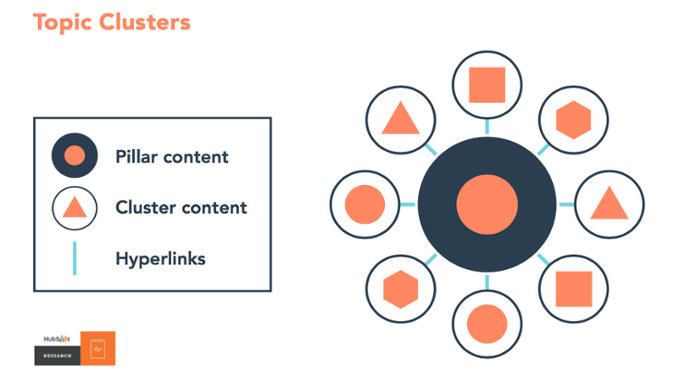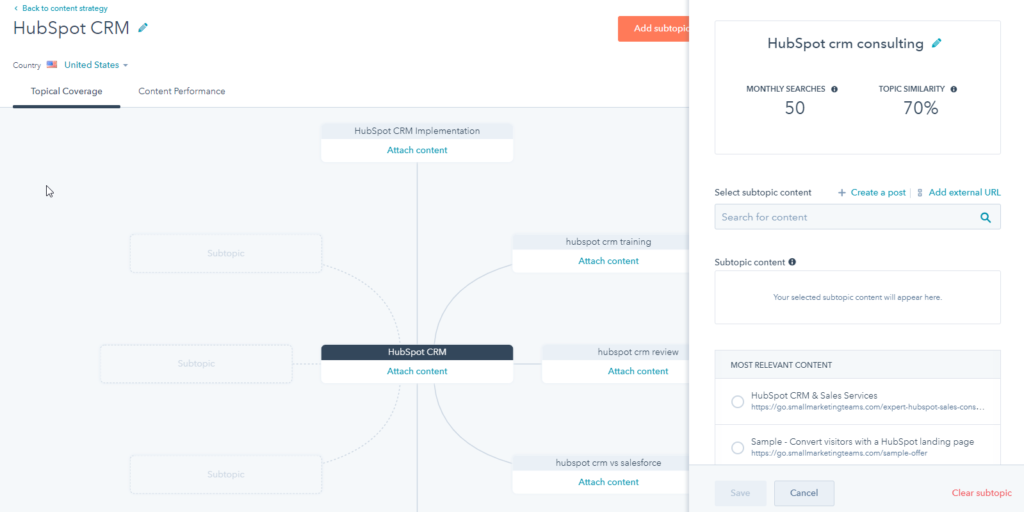Phones brought us mobile connection. The internet brought us messaging and online resources. Social media brought us global communities, and video chat brought us into each other's offices and living rooms once again.
The search engine enabled us to find answers and products in seconds. For the first 15 years since search engines became a part of our daily lives, their features defined how we used it.
In this world, marketing became defined by keywords as people learned to tell a computer algorithm what they're looking for.
Searches were short and simple. Results were sorted and presented by matching keywords in a search query to the keywords in a specific article and backlinks from high-authority domains. Blog posts were each one-off competitors, straining for page status and user recognition.
But technology has gotten much smarter. The question is...has your content strategy evolved with it?
With the help of AI and advanced algorithms, search engines have adapted to our more natural search for answers.
In this guide, I'm going to share a sizable change in the way search engines work and how you can capitalize on it to increase traffic and leads.
Let's discuss the following:
- How Human Behavior Changed SEO
- Introducing Topic Clusters Into Your Blogging Plan
- What is Pillar Content?
- How to Structure Your Topic Clusters in Your Content Strategy
- What Makes an Effective Pillar Post?
- Adapting Your Content Plan to Use Pillar Pages and Topic Clusters
- 15 Examples of Pillar Content
How Human Behavior Changed SEO
The way humans want to interact with technology is once again the primary influence on how we use the tools already in place.
Between voice search from our new AI and smart home devices, to the increasing complexity of the internet itself, searches are becoming more closely aligned with the way that humans think, speak, and seek answers.
What started as "long-tail keywords," using two or three grouped keywords to identify a searcher's goals, has grown into what looks like conversations with the search engines. Where once, searches looked like "ice cream in Boston," they are now looking more and more like "Where can I find a good ice cream shop nearby?"
Search engines and their machine-learning capabilities have also made it possible to perform more complex searches and respond to conversational queries with great accuracy. When search engine users request something using natural and conversational phrasing, the engine is now much more likely to find, compile, and offer them relevant pages.
In technical terms, you'll hear this referred to at the rise of "semantic search." Modern search algorithms are built on this study of words and how they connect.
Of course, it doesn't stop there.
Search engines have also started increasing the quality of their results by including keywords that are not exact matches, but mean the same thing as the keywords used for the initial search.
A search for "tennis shoes," for example, can also now show results for "sneakers" since the search technology assumes that the user wanted the full range of content about this particular kind of shoe - regardless of what words writers use to reference the item. This is also true for most other searches.
Introducing Topic Clusters Into Your Blogging Plan
In traditional blogging, every single article competes for search engine results independently. In fact, other articles you have written will compete against each other for a spot on the top results page.
Topic clusters change this.
Topic clusters take the SEO power out of the hands of individual web pages and build authority around groupings of related articles and web pages on a specific topic. They signal to search engines that you have topic expertise. This, along with other search signals, including your backlink profile, tells search engines which of your articles to surface in each search engine results page.
Instead of writing one article at a time on any industry-related topic, a topic cluster is essentially a group of detailed articles that all fall into the same general topic category. These topics are then inter-linked to each other using anchor text. Cross-linking the articles in your topic cluster means that any one article can effectively open easy and convenient access to your other related content.
Topic clusters leverage a search engine's focus on "user intent," not just actual keywords typed in a search box, to allow blog writers to create more topic-accessible content that can help users find the information they're looking for.
It also ensures that, if one of your articles ranks, it doesn't compete with (and brings up the search rank of) all other articles in the same cluster.
How Google's Search For Quality Answers Impacts Your Content Strategy
As I laid out above, content marketing continues to change dramatically as the technologies we rely on receive continuous updates. Despite all the fuss about our attention spans getting shorter, users have begun to favor long-form content. Google recognized this trend as early as 2013, when they found that 10 percent of users were seeking in-depth content in search results.
Content considered "in-depth" tends to be 2,000 words or longer, often including in-page navigation links, like an ebook. Long-form content communicates authority and expertise. In a digital landscape saturated with cheap, surface-level blog posts, consumers have come to get more value from depth - and Google has incorporated that signal into how they rank search engines results.
While these developments sound like helpful good sense, they are also changing the game for bloggers and SEO copywriters. A keyword doesn't mean what it used to.
What is Pillar Content?
A pillar post or page is a high-quality, long-form piece of content packed with value for your audience. Pillar posts have multiple functions.
They drive traffic to your site and generate backlinks. But pillar content also acts as a foundation for other blog posts. You can create a series of smaller blog posts about topics related to your pillar. These posts are called topic clusters.
While topic clusters give your audience even more value, they also benefit your website's SEO by providing several opportunities for internal links between pillar and cluster posts. Today the pillar-topic cluster approach is well-recognized as an effective blogging strategy.
How to Structure Your Topic Clusters in Your Content Strategy
Pillar pages are the center of your hub and spoke content model. A pillar page is what pulls a topic cluster together, makes it cohesive, and makes the entire cluster ultimately more search-engine friendly.
It is the most comprehensive article on the topic. Think of it as the most definitive article in your industry on a topic.
Each topic cluster ideally is built around a single pillar page, the center of the cluster, and also containing the central premises.
What Makes an Effective Pillar Post?
You know pillar content needs depth, but what else creates an effective pillar post?
First, consider the type of content you'd like to cover, starting with your blog's general topics. Your pillar post should be broad enough to attract visitors and lend itself to several spin-off topics.
For example, "Content Marketing" might be the starting topic that leads you to a specific pillar post like, "How to Generate More Leads With Content Marketing."
Characteristics of "Search-Engine Worthy" Pillar Content
Treat your pillar post like a guide. People often view them as ebooks or whitepaper in the form of ungated blog posts. Provide clear navigation through hyperlinks or drop-down menus.
- Educational vs. sales/product-focused
- Comprehensive vs. coving one aspect of the topic
- Used images, video, and data vs. text-only articles
- Demonstrates your expertise vs. your opinion
- Evergreen vs. timely
- Longer vs. shorter
A good pillar page is built with the idea of expanding the content into separate posts as its core purpose. This means that while it may dive deep into your general topic in your pillar page, it leaves room to cover additional information and angles in detail in the sub-topic articles of your topic cluster.
Pillar pages are supposed to be thorough and, in the new world of clever search engines, they are often the article brought up in results because they mention so many potentially related search result topics.
From there, readers can choose to deeply explore a topic covered on your pillar page by clicking the links inside the subheader descriptions. This will help them get a really thorough overview of their topic of interest and pursue detailed information on any subtopic they want.
Adapting Your Content Plan to Use Pillar Pages and Topic Clusters
When talking about topic cluster blogging, you may hear reference to blog "architecture," but don't worry, you won't need new website or blog software to make the switch.
(I should note that marketing software, like HubSpot, includes content strategy tools to help you plan, organize, and optimize your topic clusters.)
All you need is to start thinking of and designing your blogs in pillar-and-cluster formation, instead of each article being an independent stand-alone piece or part of a series.
Always start with your pillar article, the one that will thoroughly cover the subject matter and branch out into your subtopic articles. Your pillar page pulls everything together and, ideally, will also become your primary landing page for people visiting your website after searching for this topic.
Pillar pages should get the majority of your SEO focus because they will become the welcoming point for search engine users and potential leads looking for specific information. Your pillar page provides context and a quick answer to many related search questions while linking readers to more detailed articles about the specific information they're looking for.
To avoid the overwhelm of creating a 2,000-5,000 words blog post, start your pillar content as an outline. This also allows you to redesign your pillar page to include new sub-topics as you think of them.
Pillar posts include elements that you don't usually see in blog posts, including:
- Table of contents at the top (with anchor link to the section below)
- Clear section or chapter headers
- Images illustrating examples and concepts
- Videos (they don't have to be videos you created)
- Embedded presentations
- Data and charts
Finally, include internal links throughout the article to other relevant content you've produced. Based on your pillar content, write additional blog posts, called "sub-topic posts," covering related topics to generate more links to and from your pillar.
Subtopic articles, on the other hand, can be more organic and free-form because their primary goal is to inform. Throughout both the pillar and subtopic articles, be sure to helpfully reference other articles in the cluster whenever a particular subtopic comes up in discussion.
15 Examples of Pillar Content
Let's look at 15 examples of pillar content done well.
1. Typeform, Customer Success: Nearly Everything You Need to Know
Typeform offers an in-depth look into how to achieve customer success through steps. While the guide is comprehensive with a unique design, what stands out the most is the sticky navigation menu that moves as you scroll.
2. Matthew Barby, 21 Customer Acquisition Strategies to Win New Customers
As HubSpot's Director of Acquisition, Matthew Barby knows acquisition. His post is filled with helpful information straight from an industry expert. A nice touch is the "last updated" tag, which lets readers know that this post is kept up-to-date and relevant.
3. HubSpot, Instagram Marketing
The subtitle of this guide is "How to Create Captivating Visuals, Grow Your Following, and Drive Engagement." That's a lot to promise, but HubSpot doesn't disappoint. They do an exceptional job linking to smaller posts in their topic cluster, which is no surprise as HubSpot is one of the biggest proponents of the pillar-cluster approach to blogging.
4. Zapier, The Ultimate Guide to Remote Work
Zapier is a productivity app targeting one of their audience segments with this post. They clearly explain the purpose and intended audience for this guide up front. As a company with remote workers themselves, Zapier speaks from experience. Their 14 chapters follow a "how to" format for easy use.
5. ProfitWell, The Anatomy of a SaaS Marketing Site
Profit Well's SaaS DNA Project provides free SaaS research and education. Their content mirrors their mission, clear takeaways and two in-depth case studies. If you don't have time to go through all the research at once, they offer a free pdf download to read later.
6. GoodUI, GoodUI Evidence
This Evidence page is actually a landing page for gated content. Yet GoodUI does a stellar job of creating a page that is valuable on its own. From its initial subheader emphasizing the scope of their research (115 tests), to their engaging visuals, GoodUI uses pillar content to present a strong case.
7. HelpScout, Acquiring Customers with Email
HelpScout's email marketing guide, which teaches "How to Turn Your Email Newsletter into a Conversion Machine," offers a free pdf download. Their guide is littered with good-looking visual aids and strong examples.
8. GatherContent, UX Design and Content Strategy: The Project Guide
GatherContent offers a comprehensive guide for anyone needing to do UX design or strategy. Read online or in a pdf with easy hyperlink navigation and several slide-like sections to keep your attention.
9. Gleam, 15 Pre-launch Growth Hacking Strategies for Startups
While simple, Gleam's Pre-launch guide has generated over 40k inbound visitors with a 25 percent lead conversion rate. This guide provides clear, highly relevant sections. They also encourage shares with several pulled quotes that readers can "click to tweet."
10. Neil Patel, Growth Hacking Made Simple: A Step-by-Step Guide
The title of this guide immediately communicates value. This guide is approachable to a beginner audience, but easy navigation allows advanced users to skip sections as desired. Neil Patel also includes an easy-to-read history of growth hacking before diving into concrete, actionable steps.
11. Backlinko, Link Building for SEO: The Definitive Guide
If you're looking for a pillar post with a beautiful and consistent design, Backlinko is the perfect example. Naturally, they include plenty of visual examples, helpful tips, insider industry information, and the ability to download it all as a pdf.
12. Kissmetrics, How to Know if Your Content Marketing Just Isn't Working
This pillar post demonstrates that you don't need amazing design skills to craft a strong pillar post. The content is chock full of resources, including links to outside sites.
13. Copyblogger, Email Marketing: How to Push Send and Grow Your Business
Copyblogger's pillar page functions as a landing page for an ebook, but like GoodUI, the page stands on its own. They do a stellar job building links to relevant cluster posts in a clean, easy-to-read format.
14. The Write Life, The 100 Best Websites for Writers in 2018
This list resource is a different kind of pillar page that draws traffic despite most of its links going to other sites. The Write Life compiles an annual guide that its readers have come to expect. Such a massive resource easily collects, shares, and inbounds links.
15. Shopify, The Ultimate Guide to Dropshipping
Instead of one page, Shopify's Dropshipping guide is a collection of 11 chapters, each on a separate page. The main page houses the menu, which users can share and link. Yet each chapter functions as a topic cluster post, boosting SEO and increasing site visit duration. But if you prefer to read the information in one place, you can download a pdf.
These pillar page examples present a wide range of options. Not all pillar posts look the same. Yet they all contribute to powerful content strategy.
Pillar Content Takeaway
While creating extraordinary content that serves your audience takes time, adapting to the new topic cluster blogging style isn't hard at all. In fact, many people have already been doing similar variations simply by optimizing blog articles that they have already published.
This is your opportunity to get more eyes and better leads through more cohesive and inter-linked topical content. The newest approach to blogging relies on pillar posts.



